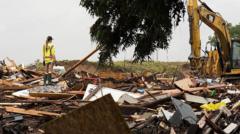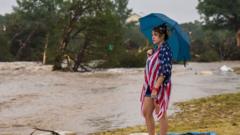Following severe floods in Texas, some lawmakers are connecting federal workforce cuts to the U.S. National Weather Service's ability to accurately predict weather patterns. While staffing at the NWS decreased under the Trump administration, experts suggest that forecasts during the flood event were still timely and accurate.
Texas Floods: Did Federal Workforce Cuts Impact Emergency Response?

Texas Floods: Did Federal Workforce Cuts Impact Emergency Response?
In the wake of devastating Texas floods, questions arise regarding the potential role of Trump-era federal workforce reductions in the effectiveness of weather forecasting.
In the aftermath of the catastrophic floods in Texas, some Democratic lawmakers have pointed a finger at workforce cuts enacted during the Trump administration, arguing that they may have hindered the National Weather Service's (NWS) capacity to predict and warn residents of severe weather. Senator Chris Murphy remarked, "Accurate weather forecasting helps avoid fatal disasters," implying that a reduction in meteorologists could have dire consequences during such emergencies.
However, White House Press Secretary Karoline Leavitt dismissed these claims, asserting that current staffing at the NWS was adequate. BBC Verify's investigation into these staffing numbers reveals that while workforce cuts had occurred, they did not directly correlate with the recent flooding incidents.
The Trump administration proposed a significant 25% cut to the National Oceanic and Atmospheric Administration's (NOAA) $6.1 billion budget, which oversees the NWS, set to take effect starting FY 2026. Nonetheless, earlier staff reductions have already seen approximately 600 employees—about 14% of the NWS workforce—leave the agency due to buyouts, early retirements, and firings initiated under a Department of Government Efficiency program.
Reports indicate that many NWS offices across the country are operating with personnel shortages, and recent data showed a vacancy rate of up to 20% in half of its offices, significantly higher than a decade prior. Despite these staffing challenges, climate experts maintain that the NWS issued timely forecasts and warnings for Texas’s flood event.
Avantika Gori, a civil and environmental engineering assistant professor at Rice University, stated, "The challenge with this event was that it is very difficult to forecast this type of extreme, localized rainfall." Similarly, Andy Hazelton, a former NOAA climate scientist, emphasized that despite staffing issues, the warnings were properly communicated.
Nonetheless, some experts believe that local coordination could have been compromised. Daniel Swain, a climate scientist from UCLA, expressed concerns about the communication channels that relay essential weather information, suggesting that key personnel vacancies in local NWS offices might have impacted the responsiveness of emergency services.
While NWS officials have confirmed that additional staffing was implemented in anticipation of this flooding, they acknowledge that certain critical positions remain unfilled. For instance, the San Angelo office was reported to lack a senior hydrologist, crucial for forecasting floods, while the San Antonio office missed a "warning coordinating meteorologist."
When asked if federal cuts contributed to staff shortages, former President Trump asserted there were no unfilled key positions at the NWS.
Another significant point that has stirred public debate is the purported reduction in weather balloon launches, an essential method for gathering atmospheric data crucial for weather forecasting. Meteorologist John Morales claimed a 20% reduction in weather balloon releases due to staffing shortages has degraded forecast quality. However, investigations showed that those affected by the cutbacks were not directly related to the Texas floods, and launches continued as normal in affected areas.
In conclusion, while there are valid concerns about workforce cuts affecting the NWS's long-term capabilities, the immediate responses during the Texas floods were reportedly adequate, underscoring the challenges inherent in forecasting extreme weather events.
However, White House Press Secretary Karoline Leavitt dismissed these claims, asserting that current staffing at the NWS was adequate. BBC Verify's investigation into these staffing numbers reveals that while workforce cuts had occurred, they did not directly correlate with the recent flooding incidents.
The Trump administration proposed a significant 25% cut to the National Oceanic and Atmospheric Administration's (NOAA) $6.1 billion budget, which oversees the NWS, set to take effect starting FY 2026. Nonetheless, earlier staff reductions have already seen approximately 600 employees—about 14% of the NWS workforce—leave the agency due to buyouts, early retirements, and firings initiated under a Department of Government Efficiency program.
Reports indicate that many NWS offices across the country are operating with personnel shortages, and recent data showed a vacancy rate of up to 20% in half of its offices, significantly higher than a decade prior. Despite these staffing challenges, climate experts maintain that the NWS issued timely forecasts and warnings for Texas’s flood event.
Avantika Gori, a civil and environmental engineering assistant professor at Rice University, stated, "The challenge with this event was that it is very difficult to forecast this type of extreme, localized rainfall." Similarly, Andy Hazelton, a former NOAA climate scientist, emphasized that despite staffing issues, the warnings were properly communicated.
Nonetheless, some experts believe that local coordination could have been compromised. Daniel Swain, a climate scientist from UCLA, expressed concerns about the communication channels that relay essential weather information, suggesting that key personnel vacancies in local NWS offices might have impacted the responsiveness of emergency services.
While NWS officials have confirmed that additional staffing was implemented in anticipation of this flooding, they acknowledge that certain critical positions remain unfilled. For instance, the San Angelo office was reported to lack a senior hydrologist, crucial for forecasting floods, while the San Antonio office missed a "warning coordinating meteorologist."
When asked if federal cuts contributed to staff shortages, former President Trump asserted there were no unfilled key positions at the NWS.
Another significant point that has stirred public debate is the purported reduction in weather balloon launches, an essential method for gathering atmospheric data crucial for weather forecasting. Meteorologist John Morales claimed a 20% reduction in weather balloon releases due to staffing shortages has degraded forecast quality. However, investigations showed that those affected by the cutbacks were not directly related to the Texas floods, and launches continued as normal in affected areas.
In conclusion, while there are valid concerns about workforce cuts affecting the NWS's long-term capabilities, the immediate responses during the Texas floods were reportedly adequate, underscoring the challenges inherent in forecasting extreme weather events.





















